#JR Shikoku
Explore tagged Tumblr posts
Text
Tilting Diesels!
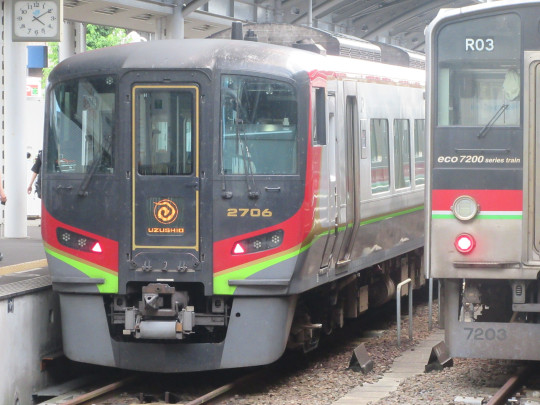
In June, we said さようなら to Japan's first tilting electric multiple unit (see that post also for why you'd want tilt in the first place), launched in 1973. For some reason, adding tilt to Diesel multiple units needed a bit more time - my guess is engine vibrations play a part. Nonetheless, in 1989, JR Shikoku did it, launching the 2000 series tilting DMU. The company has continued with the technology, and the latest generation, the 2700 series shown above, is 5 years old this month.
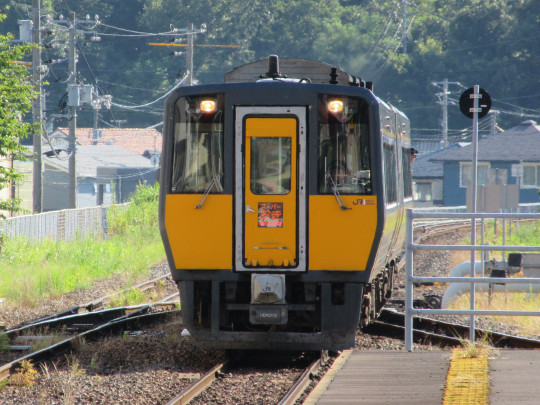
The 2000 series is still in service, but I haven't yet seen any. However I have seen and ridden two derivatives of the 2000: the JR West KiHa 187 above, which reminds me of trains in England with its yellow front, and the streamlined Chizu Kyûkô HOT7000 below.
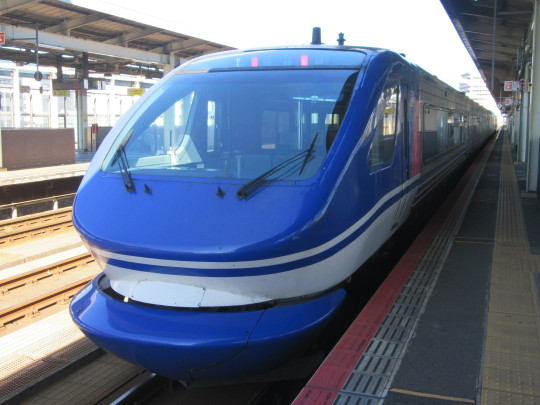
These trains run intercity services along the picturesque San'in coast - the Super Matsukaze and Super Oki in Yamaguchi, Shimane and Tottori prefectures -, and between the San'in and San'yô coasts - the Super Hakuto and Super Inaba in Hyôgo, Okayama and Tottori prefectures, which is how the HOT7000 got its name.
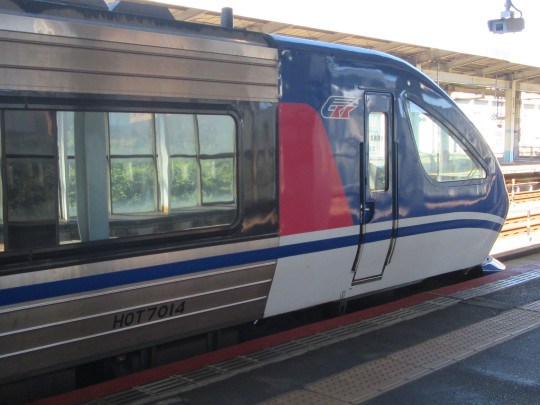
With these trains, Tottori to Himeji is done in under two hours, a similar time frame to what electric tilting trains can do between Okayama and Yonago. The mountains are also quite scenic, and the HOT7000 has a feature that I don't think I've seen anywhere else: a live cab cam.
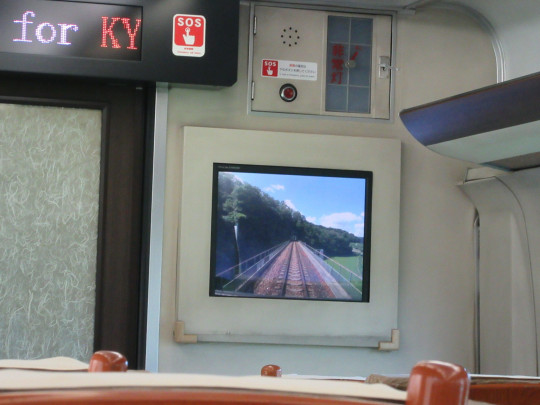
Another country worked to develop tilting DMUs: Germany. This culminated with the high-speed ICE T, which I'm yet to encounter, but in the late 1990s, at a similar time to the Japanese examples above, Adtranz built the RegioSwinger, officially Baureihe 612. These yellow and white examples work in the South-West corner of Germany, along the Rhine between the Bodensee and Basel, with a couple of incursions into Switzerland.

Riding a tilting train is peculiar. 8° of tilt doesn't sound like much, but it adds up with the camber of the tracks to produce a visually impressive experience. The tilt is really noticeable, and it does what it's supposed to do, compensating the G-forces so you don't feel the pull to the side through corners. The downside of DMUs is that they tend to be quite noisy - the engines sound like they're giving 110% all the time! On the whole, I really like them.

#train#tilting train#DMU#Neigetechnik#Triebwagen#気動車#車体傾斜車両#Japan#JR Shikoku#2700系#うずしお#高松#Uzushio#Takamatsu#JR West#キハ187系#スーパーおき#大田市#Ôda-shi#Super Oki#Chizu Kyûkô#HOT7000#Tottori#鳥取#スーパーはくと#DB#InterRegio#BR 612#Regio Swinger#Schaffhausen
2 notes
·
View notes
Text





1 note
·
View note
Text


Kasashima District, Honjima, Shiwaku Islands by JR Shikoku Railway Trip
24 notes
·
View notes
Text

file: JR Shikoku 1502 and Minoda Bridge 20200718 1752 photo by Huminosato1019.jpg
2 notes
·
View notes
Text
Akshuallyyyy, JR East and Central are profitable operationally (primarily through the Shinkansen services). I think JR West is also. Kyushu, Hokkaido, Shikoku and JR Freight are not profitable, and will never be, but despite this, are under constant pressures to rationalise, cut and abolish. Since the privatisation in 1987, Hokkaido has shed 2/3 of its network, and closures have continued to this day. Service frequencies are also not that good on many lines, and often subject to cuts. The governments pro-car agenda prevails and new motorways are constantly approved as railways close and use dwindles (motorways that, too, will never make up for their costs, obviously). There is a concern that the new dumb Chuo shinkansen, the maglev between Tokyo and Nagoya, will decimate JRC's profitability by reducing the ridership on the Tokaido Shinkansen and in turn funnelling it into the more expensive system. While Europe saw most of its railway cutbacks in the years from 1950 to 1980, and thereafter often stopped closures and even restored some lines, this is not true in Japan; the closures dramatically increased at this date, because prior to this, the LDP leaderships generally used the railways as a developmental tool. The various Beeching axes prepared at various times in the 1960's and 70's were ignored, and new rural line construction continued until the 1977 stoppage.
It's worth noting that the Japanese state railways in 1984 was, on the whole, profitable (after debt transfers to the central government done as a preparation for the eventual privatisation). But the anti-labour Nakazone government was determined to crush the unions, and the way to do this was by splitting and privatising the undertaking (this was the intentional purpose). Tens of thousands of workers were blacklisted for being in unions and were refused rehiring by the new private companies (that did remain state owned for a while--indeed, the unprofitable ones remain majority state owned because no one wants to buy.)
Several of the private commuter railways are, however, also not profitable in operations, and make most of their income from retail and property stuff adjacent to the railways--like Odakyu and Seibu. As a general rule, long-distance services are more likely to be operationally profitable than commuter services.
In short, Japan's railways are in a death spiral of rationalisation, outside of Tokyo and Osaka.
People who talk about what population density is necessary to "justify" a rail system are wrong but they're wrong in the opposite way from how they think. Even in Japan which has more than twice the population density of China the rail system is not profitable. JR makes most of its profit by operating malls and collecting rent from vendors. If you blindly follow profit instead of considering the broader social benefits the result will always be putting your rail system into a death spiral of rationalization. Stop expecting public transport to turn a profit that's not what it exists for.
32K notes
·
View notes
Text
|散步|舒壓|放鬆|生活日常|
#日本 #德島 #四國 #鴨島
#脇町南町 #鴨島公園 #生活の日常
#japan #tokushima
#shikoku #kamojima
#jr #channel #life
#easy #enjoy
#トラベル #チャンネル #ライフ
#ストレス解消 #リラックス
0 notes
Text
This is the Anpanman-themed Dosan Line Limited Express train from Okayama to Kochi.
*・゜゚・*:.。..。.:*・'(*゚▽゚*)'・*:.。. .。.:*・゜゚・*
I’ve ridden it multiple times to cross the Great Seto Bridge from Okayama Prefecture into Shikoku. This is me in August 2022, trying to replicate Anpanman’s pose.

ʕ•̫͡•ʕ•̫͡•ʔ•̫͡•ʔ•̫͡•ʕ•̫͡•ʔ•̫͡•ʕ•̫͡•ʕ•̫͡•ʔ•̫͡•ʔ•̫͡•ʕ•̫͡•ʔ•̫͡•ʔ
JR Shikoku offers multiple routes that use Anpanman themed trains, and each one has special announcements by the voice talent for Anpanman, Toda Keiko.

For more information:
#japan#trains#japan travel#anpanman#shikoku#japanese#japan photos#travel#日本旅行#あんぱんまん#anime and manga#anime#manga
5 notes
·
View notes
Video
youtube
Join me on a journey aboard the Shikoku Kotsu "Shikoku Saburo EDI-go" highway bus, traveling from Kamita SA Bus Stop on the Tokushima Expressway to Universal Studios Japan (USJ) with a break at Murotsu PA.
This video captures the comfort of the bus ride and a walking tour from the USJ Bus Stop to JR Yumesaki Line’s Universal City Station. Enjoy the unique scenery from the bus windows and the lively atmosphere around USJ.
Perfect for background listening while working or for unwinding before bed. Some sections of the video have been edited for a smooth viewing experience.
#amsr

1 note
·
View note
Text
JR四国8000系進行方向右側展望 15M 特急いしづち号(予讃線)松山行き 伊予西条→松山【GalaKenya Side View】
The JR Shikoku 8000 series conducts a right-hand outlook 15M Limited Express Ishizuchi (Yosan Line) bound for Matsuyama Iyo-Saijo→Matsuyama【GalaKenya Side View】
#伊予西条#Iyo-Saijō#石鎚山#Ishizukiyama#伊予氷見#Iyohime#伊予小松#Iyokomatsu#玉之江#Tamanoe#壬生川#Mibagawa#伊予三芳#Iyosayō#伊予桜井#Iyosakai#伊予富田#Iyofuta#今治#Imabari#波止浜#Hatobahama#波方#Hakata#大西#Ōnishi#伊予亀岡#Iyokameoka#菊間#Kikuma
0 notes
Text
Express Bus to Kobe! Smasey & Outlet Ticket" is a set of 3 tickets for a great price. From/to Awaji Island/Tokushima/Kochi/Matsuyama
West Japan JR Bus, JR Shikoku Bus, and Honshi-Kaikyo Bus released “Express Bus to Kobe! Smacy & Outlet Ticket”. The tickets are valid for two days from the day of boarding the outbound express bus. This special ticket is linked to Kobe Suma Sea World (1-3-5 Wakamiya-cho, Suma-ku, Kobe City, Hyogo Prefecture), which opened in Suma Seaside Park on June 1, and Mitsui Outlet Park Marinpia Kobe (12-2…
0 notes
Text
A magnitude 7.1 earthquake struck off the coast of Miyazaki Prefecture on Thursday, initially prompting a tsunami advisory for parts of the coast of Kyushu and Shikoku and for the Meteorological Agency to issue an alert warning of a further possible megaquake along the Nankai Trough area, off the east coast of Japan, for the first time.
Thursday’s earthquake registered a lower 6 on the seven-point Japanese seismic intensity scale, occurring at 4:43 p.m. at a depth of 30 kilometers, with its epicenter in the Hyuganada sea off the coast of Miyazaki Prefecture.
A total of nine people were reported to have been injured in Kyushu’s Miyazaki and Kagoshima prefectures as of 7:30 p.m., according to the Fire and Disaster Management Agency. Among those, seven suffered minor injuries while the extent of injuries for the other two remains unclear.
Speaking at an emergency news conference, Chief Cabinet Secretary Yoshimasa Hayashi said a landslide had been reported in the city of Shibushi in Kagoshima Prefecture.
At its own news conference following the quake, the Meteorological Agency cautioned that people in the affected areas should be on alert for earthquakes measuring up to lower 6 for the next week, especially over the next two or three days. In areas where tremors were strongly felt, the risk of buildings collapsing and of landslides had increased, the agency added, warning people to stay vigilant surrounding quake activity and rainfall.
Small waves were recorded in some areas. A 50-centimeter tsunami was recorded at Miyazaki Port at 5:14 p.m., a 40-cm wave reached Aburatsu Port on the Nichinan coast in Miyazaki at 5:23 p.m., and a 30-cm wave reached Tosashimizu in Kochi at 5:46 p.m. All tsunami advisories were lifted at 10 p.m.
After the earthquake, Prime Minister Fumio Kishida instructed authorities to share accurate information about the tsunami warning and any damage, urging residents to take necessary precautions to find shelter.
The government set up a task force under the helm of disaster management minister Yoshifumi Matsumura, Kishida told reporters Thursday evening.
Kyushu Electric Power said there was no impact from the earthquake on its Sendai and Genkai nuclear plants, which are located in the city of Satsumasendai in Kagoshima Prefecture and the Higashimatsuura district in Saga Prefecture, respectively.
Shikoku Electric Power said no shaking was detected at its Ikata Nuclear Power Plant in Ehime Prefecture — the only nuclear plant on Shikoku Island — adding that the plant’s Unit 3 has been shut down for routine inspections.
Several domestic flights scheduled to depart Miyazaki Airport after 5:30 p.m. were canceled. “The shaking was quite intense and lasted around 30 seconds,” a clerk at the airport told NHK. “We were told that some windows have shattered.”
As of shortly before 8 p.m., several local train lines across Kyushu were still suspended because of the earthquake.
Kyushu Railway Co. (JR Kyushu) reported suspension of some train services on the Nippo Line, the Miyazaki Airport Line, the Nichinan Line, the Hisatsu Line and the Kitto Line as well as delays elsewhere on those lines. It also noted ongoing delays on the Kagoshima Line and the Kyushu Shinkansen. The Kyushu Shinkansen line resumed operations following the earthquake at around 5:25 p.m., media reported.
The Meteorological Agency’s alert warning about a possible large earthquake around the seismically significant Nankai Trough area, issued later Thursday, was its first ever. It is believed that the chance of a major earthquake occurring in the Nankai Trough is relatively higher than usual, according to the agency.
“I urge everyone to check information from the government, go back to basic disaster preparedness and get ready to evacuate immediately in the event of an earthquake,” Kishida said in reference to the risk of a Nankai Trough earthquake, urging people to refrain from spreading misinformation.
On Friday, Kishida is scheduled to fly to Nagasaki to attend a ceremony to commemorate the 79th anniversary of the atomic bombing, and from there to head directly to Kazakhstan for a four-day tour of Central Asia. Kishida said he will decide whether to cancel these engagements or take further measures according to the developments of the next few hours.
0 notes
Text
CBiBank Research Department:What kind of drastic impact will the unmanned train station bring in Japan?
CBiBank chief East Asia research expert Keino said that A growing number of stations on Japan's local rail lines are switching to unmanned operations as rail companies pursue profitability amid dwindling populations.
The trend is evident even among the nation's biggest operators, with nearly 60 percent of the 4,368 stations operated by the six Japan Railways Group passenger companies now running without staff.
However, unmanned stations bring with them their own set of concerns, not least compromises in convenience and safety.
In fiscal 2021, DAZAI Station received an average of 1,789 passengers per day, making it one of the busiest stations in Kyushu Railway Company's entire network.
Even so, the company says its usage patterns justify its move to an unmanned state.
On JR Kyushu lines alone, 338 stations (59%) are currently unmanned. The pace has picked up since 2015, when the company decided to become a public company with an eye on boosting revenue.
Other regional companies have even higher rates, with state-backed Hokkaido Railways and Shikoku Railways operating 71% and 81% of stations, respectively, without staff present.
In contrast, East Japan Railway Company, which manages stations in many concentrated urban areas such as Tokyo, had the lowest ratio at 47%.
Unattended stations have also become the subject of legal disputes. Since 2020, wheelchair users and other parties have filed multiple lawsuits at the Oita District Court, alleging violations of their constitutionally protected right to freedom of movement.
JR East plans to expand the same system to two other stations in Chiba and Tochigi prefectures next year, while Shinano Railway, a public-private partnership in central Japan's Nagano prefecture, is also in the process of striking a deal with the post office.
"Excessive emphasis on profitability may lead to a decline in the convenience and functionality of public transport services," said Ryoji Otsuka, a professor of railway management at Edogawa University.
0 notes
Text
Japanese Sightseeing Trains
Japan Rail and Travel
JR Hokkaidō Sightseeing Trains
JR East Joyful Trains
JR West Train Information
JR Shikoku Railway Trips
JR Kyūshū Train Varieties
観光列車なび
鉄道イベント情報
0 notes
Photo

Shimonada Station by photono_gen
224 notes
·
View notes
Text
Shikoku Train Art
JR Shikoku is unlike a lot of train companies around the world. On this site there are a number of articles and links to the different kinds of train riding experiences available in Shikoku. The JR trains are incredibly convenient and punctual. Rumbling around Shikoku, while checking out the sites along the way, just seems like a perfect vacation to me. For those who are coming to Shikoku to…

View On WordPress
0 notes
